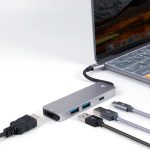Are you tired of constantly plugging and unplugging your laptop from various peripherals? Do you wish there was a way to streamline your workspace and increase productivity? Look no further than your Dell docking station.
Setting up your docking station may seem daunting at first, but with this step-by-step guide, you’ll have it up and running in no time.
From gathering your equipment to troubleshooting common issues, we’ve got you covered.
So, grab your laptop and let’s get started on streamlining your work setup.
Table of Contents
Gather Your Equipment
Get ready to feel like a tech wizard as you gather all the equipment you need for your Dell docking station setup!
First off, ensure that you have the correct Dell docking station for your laptop model. If you’re not sure, check the Dell website or ask a sales representative. You’ll also need a power source for the docking station, so make sure you have an outlet nearby.
Next, gather the necessary cables. The Dell docking station typically comes with a USB-C cable that connects to your laptop, but you may need additional cables to connect external devices. Check which ports your docking station has and which devices you plan to connect. You may need an HDMI cable for a monitor, an Ethernet cable for internet connectivity, or a USB cable for a printer. Make sure you have all the cables you need before starting the setup process.
Ensure that you have all the devices you plan to connect to the docking station. This includes your laptop, of course, but also any external devices such as monitors, keyboards, mice, speakers, or printers. Check that these devices are functioning properly and have the necessary cables and power sources.
With all the equipment gathered and ready to go, you’re now set to begin the setup process and transform your laptop into a desktop-like workstation.
Connect Your Dell Docking Station
Once you’ve plugged in the power cord and necessary cables, you’ll be able to easily connect your laptop to the docking station. The first step is to locate the docking port on your laptop. This is usually on the side or back, labeled with a symbol that looks like a rectangle with two vertical lines on either side.
Once you’ve located the docking port, simply align it with the connector on the docking station and gently push your laptop down until it clicks into place.
Next, make sure your laptop is properly connected to the docking station. Check that all necessary ports and connectors are securely connected. Also, check that your laptop is properly seated in the docking station and not wobbling or loose.
If you notice any issues, simply adjust the connectors or reseat your laptop until everything is properly aligned and secure.
Test your connection to make sure everything is working properly. Turn on your laptop and check that all peripherals are working as expected. Also, check that your laptop is charging properly and able to connect to any external displays or other devices connected to the docking station.
If everything is working properly, you’re all set! You can now enjoy the convenience of having a fully functional workstation that you can easily connect and disconnect from your laptop.
Configure Your Laptop
Now that you’ve connected your laptop to the docking station, it’s time to configure it for maximum productivity and efficiency. Follow these steps to ensure that your laptop is set up correctly:
-
First, make sure that your laptop is set up to work with multiple displays. Go to your laptop’s settings and select ‘Display’. From there, you can choose to extend your display or duplicate it. If you choose to extend your display, you can drag and drop windows between screens, making it easier to multitask.
-
Next, configure your laptop’s power settings. By default, your laptop may be set to ‘Balanced’, which can limit its performance. To get the most out of your machine, select ‘High Performance’ mode. This will ensure that your laptop is running at its maximum potential, which is especially important if you’re using resource-intensive programs.
-
Finally, set up any additional peripherals that you may be using with your docking station. This could include a keyboard, mouse, or external hard drive. Make sure that everything is connected correctly and recognized by your laptop. This will help you work more efficiently and minimize any potential issues.
By following these steps, you can configure your laptop for optimal performance while using your docking station. With the right settings, you’ll be able to work more efficiently and get more done in less time.
Connect Your Peripherals
To make your work more efficient, you’ll want to connect your peripherals to the docking station.
The first step is to identify the ports on your docking station and the peripherals you want to connect. Common peripherals include a monitor, keyboard, mouse, printer, and external hard drive.
Once you have identified your peripherals, connect them to the docking station using the appropriate cables. Most docking stations come with several USB ports, an HDMI port, and an Ethernet port. Make sure you connect your peripherals to the correct ports. For example, connect your monitor to the HDMI port, your keyboard and mouse to the USB ports, and your printer to the USB or Ethernet ports.
After connecting your peripherals, turn on your laptop and the docking station. Your laptop should automatically recognize the peripherals connected to the docking station. If not, you may need to install drivers for your peripherals or adjust your laptop’s settings.
Once everything is set up correctly, you can start using your peripherals as if they were directly connected to your laptop. Enjoy the convenience of having all your peripherals connected to your docking station!
Test Your Setup
Make sure everything is working smoothly by testing your peripherals and docking station. This step is crucial to ensure that you can work efficiently and without interruptions. To do this, connect all your peripherals to the docking station, including your monitor, keyboard, mouse, and any other devices you may have. Once everything is connected, turn on your laptop and check if all the peripherals are working correctly.
To test your setup, open a few applications and check if they are running smoothly. Move your mouse around and check if it is responding well. Open a few tabs on your browser and check if the internet connection is stable. If you experience any issues, check the connections and make sure everything is properly plugged in. If the problem persists, try restarting your laptop or docking station.
Testing your setup may take a few minutes, but it is worth the effort to ensure that you have a flawless work experience. To help you keep track of your progress, here’s a table to summarize the steps you’ve taken so far:
| Step | Task | Completion |
|---|---|---|
| 1 | Choose the right docking station | Done |
| 2 | Connect your peripherals | Done |
| 3 | Test your setup | In progress |
By following these steps, you can set up your Dell docking station for your laptop with ease. Remember to test your setup to ensure everything is running smoothly before starting your work. With a reliable docking station, you can work efficiently and comfortably, knowing that all your peripherals are connected and working correctly.
Troubleshoot Common Issues
If you encounter any issues, don’t panic! You can easily troubleshoot common problems with your Dell docking station and peripherals.
Here are some tips to help you troubleshoot:
-
Check your connections – Ensure that all cables are properly connected to the docking station and your laptop. Make sure that the power adapter is connected to the docking station and that it’s plugged in. If you’re using external monitors, check that your cables are properly connected to the docking station and monitors.
-
Restart your devices – Sometimes, all it takes is a simple restart to fix issues with your docking station or peripherals. Restart your laptop, docking station, and any connected devices, and see if that resolves the issue.
-
Update your drivers – Outdated drivers can cause issues with your docking station and peripherals. Check for driver updates on the Dell website and install them if necessary.
-
Contact Dell support – If you’ve tried all of the above and are still experiencing issues, contact Dell support for further assistance. They can help you troubleshoot and provide additional support if needed.
By following these troubleshooting tips, you should be able to quickly and easily resolve any issues with your Dell docking station and peripherals. Remember to stay calm and take your time when troubleshooting – sometimes the solution can be as simple as checking your connections.
Enjoy Your Streamlined Setup
Now that you have your Dell docking station and peripherals set up, sit back and relax as you enjoy the convenience of a streamlined workspace.
With your laptop connected to the docking station, you can easily switch from a desktop setup to a mobile setup by simply undocking your laptop. You can also enjoy the benefits of having multiple displays, a full-sized keyboard, and a mouse all connected to your laptop at once.
With your Dell docking station, you can also enjoy the convenience of charging your laptop while you work. This means you won’t have to worry about your laptop running out of battery during an important project. Simply connect your laptop to the docking station and let it charge while you work.
In addition to the convenience of multiple displays and charging capabilities, your Dell docking station also offers the convenience of additional ports. With the extra USB ports provided by the docking station, you can easily connect all of your peripherals without having to worry about running out of ports on your laptop. This means you won’t have to constantly unplug and re-plug devices every time you need to use them.
Now that you’ve got your Dell docking station all set up, enjoy the convenience of a streamlined workspace and get your work done with ease.
Conclusion
Congratulations! You’ve successfully set up your Dell docking station for your laptop. With this setup, you can now enjoy a streamlined workspace that allows you to connect all your peripherals to your laptop with just one cable.
This means less cable clutter on your desk and more efficient use of your time. Now, you can easily connect your laptop to external displays, printers, and other devices, all while charging your laptop.
If you encounter any issues during the setup, don’t worry. Simply refer to the troubleshooting section of this guide and follow the steps provided.
Remember to always test your setup to ensure everything is working properly. With your Dell docking station, you can now work or play with ease, knowing that you have a reliable and efficient setup that meets all your needs.
Enjoy your new streamlined workspace!



